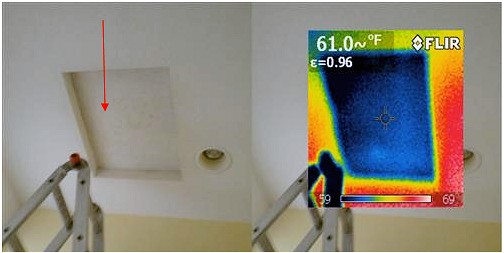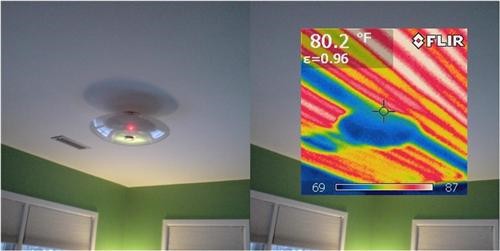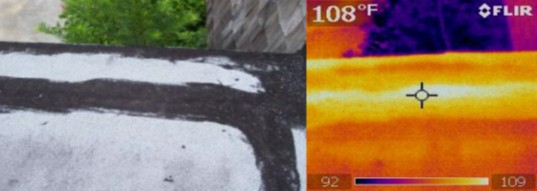Infra-red Thermo Graphic Inspections

Thermo Graphic Inspections
We offer infra-red thermo graphic inspections which are included in our standard ‘Home Inspection’ as well as an optional service as a troubleshooting tool for single-item inspections.
Infra-red inspections are carried out, which can give clues to a host of different problems with properties, like mold, moisture, ventilation and electrical problems that can cause a myriad of other problems.
Included below are some images where we have used infra-red imagery to identify the problem that could not be detected with the naked eye.

For each photo in the series below, we created a duplicate of the original image, then overlaid a infra-red thermo graphic image to illustrate the effectiveness of these inspections.
Roof Leaks
We found a lot of roofs leaking during the rainy season in South Africa. It’s pretty easy to identify the wet areas (blue) in the infra-red images, but they’re not apparent in the original photos or with the bare eye. The homes shown below had water (moisture) leaks from mainly the roof and in some instances the geyser and upstairs shower.

Roof Leak

Geyser Leak

Roof Leak Lounge
Hot Spots In Attics
Warm attics cause a ventilation problem, which in turn causes water vapour and could lead to moisture and mold. We found infra-red imagery to be invaluable while troubleshooting the causes of moisture and moisture effects in attics, walls, ceilings and subsequently the living area.
The photo below shows a warm spot in an attic that would never would have identified without infra-red imagery. The culprit was a flush-mounted light fixture with light bulbs with a wattage that was too high. We don’t make a habit of taking apart light fixtures to check the wattage on light bulbs, but we’ll do it if something tips us off.

Recessed lights are a huge contributor to warm attics, whether they’re airtight or not, as per the photo below.

Outside Moisture
Outside wall moisture retention

Improper Insulation
This is one of the most obvious uses for infra-red imagery. The photo below shows an attic access panel that wasn’t properly insulated.

Heating Systems
If an inside heater doesn’t heat up properly, it will be quite obvious with infra-red imagery. The photo below shows a heater working properly.

The image below shows a heater not heating up properly.

If there are voids or leaks in heating tubes for in-floor, in-wall, or in-ceiling heating, infra-red imagery will find them. The photo below shows an inconsequential gap (blue) in the tubing at this heated ceiling.

Heated floors can be easily inspected with Infra-red imagery, as demonstrated by the photo below.

The portions of floors that aren’t heated (blue) will be obvious as well, as seen in this photo.

Leaking Showers
We use infra-red imagery inspections to help identify leaking tiled showers on a second storey building. Through the use of infra-red imagery, we can almost always identify these leaks (blue) before they stain the ceiling below. The images below show a few examples of tiled shower leaks identified with infra-red imagery during home inspections. We always verify these leaks with a moisture meter before reporting them as leaks.

Upstairs leaking shower floor

Leaking kitchen sink

Leaking Toilet – moisture under tiles

Wet Basements
The connection of a downpipe directly to a drain. The blue area is moisture.

It is one thing to say there’s moisture intrusion in a basement, but having an infra-red image that shows the area that’s wet, really helps to tell the story and identify the reason why.
Electrical Problems
Scanning electric panels, plugs and light switches with an infra-red imagery inspection, can easily identify faults or possible future electrical problems. The DB panel shown below had an overheated neutral wire, which was the result of a loose connection. There were two neutrals connected to a single lug.

Below is a light switch test, two (red) are on and one (yellow) is not switched on and all functioning well.

Random Surprises
We may have never found this hidden floor moisture without the use of Infra-red imagery. This was a newly constructed home where a carpet was installed too soon, on a floor with moisture retention.

Moisture under a flat roof can be seen in this photo only with infra-red imagery





